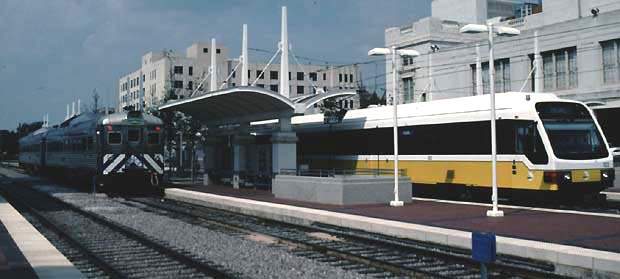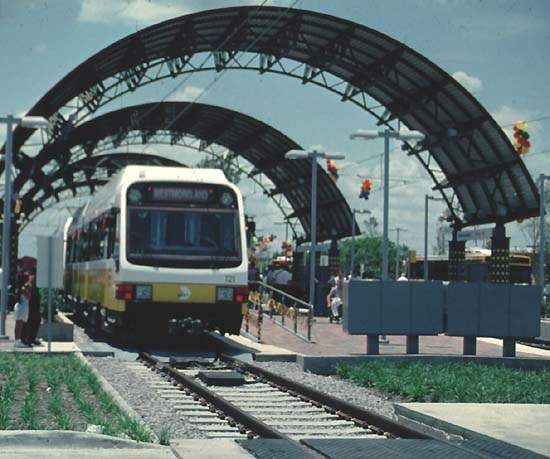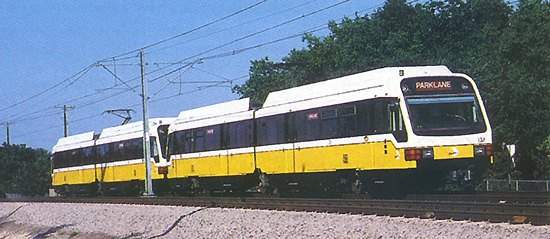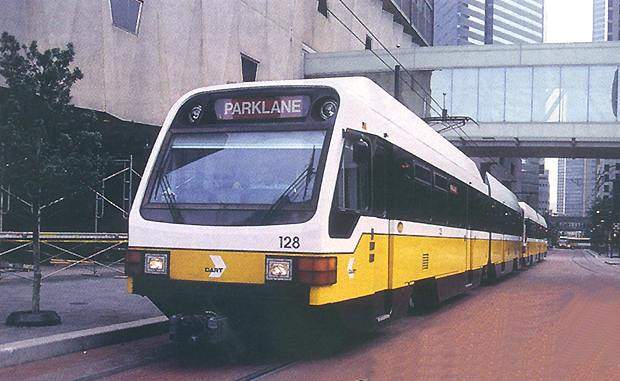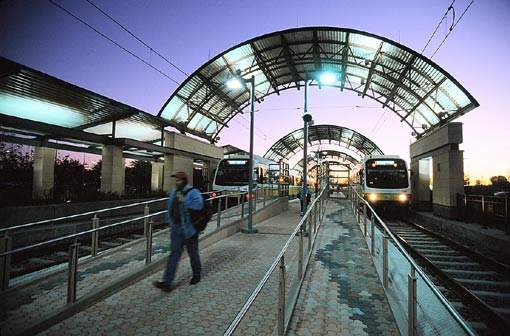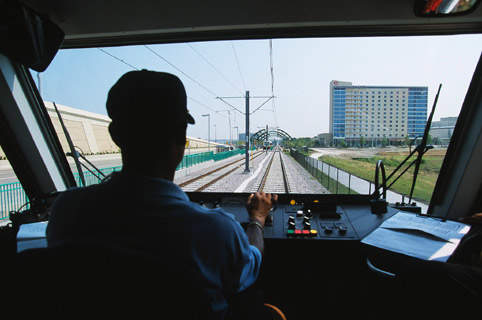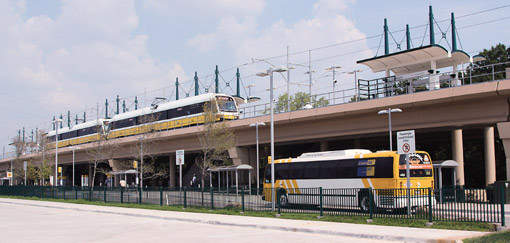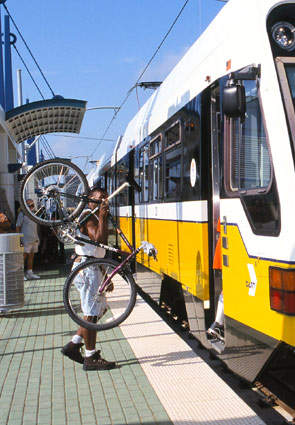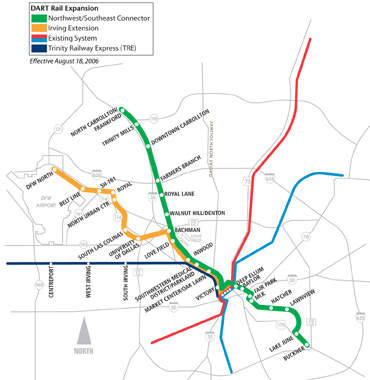The light rail system, Dallas Area Rapid Transit (DART), is to be doubled in size during the next decade following agreement on a $2.4bn investment programme. The year 2006 marked the tenth anniversary of the opening of the first 17.6km (11 mile) line with 14 stations, which has since grown to 77km (48 miles) with 39 stations overall.
Rail, light rail and bus operator DART was formed in 1983. DART light rail was instigated in the mid-1990s, as a forward-thinking project associated with a major redevelopment of Dallas. It is reaping the rewards of its major investment, having grown from carrying 1.4 million passengers in 1996 to 17.5 million in 2005. DART has become one of the largest light rail systems in the US, after Los Angeles, Newark, New Jersey, San Diego and Portland MAX.
Expansion has nevertheless been stifled by a lack of revenue, but July 2006 saw DART receive a $700m grant from the United States Federal Transport Administration towards the total project cost. Construction has encouraged developments along the route, and there are now plans for $3bn in private activity alongside the routes. A one percent sales tax approved by residents of the 13 cities benefiting from DART services helps to fund the operation.
The area continues to suffer from massive traffic congestion issues and rising pollution, and it is hoped that the planned new lines will significantly reduce the number of car journeys taken.
Dallas Area Rapid Transit system origins and lines
Dallas was a centre for electric railways in the early 20th century, when it was served by the extensive network of the Texas Electric Railway.
Suburban areas were served by an additional network of city lines, run by the Dallas Railway and Terminal Company, but this declined in the late 1950s, hastened by the introduction of the Interstate highway programme in 1956.
However, by the mid-1970s, thanks to increased traffic congestion and growing fears of pollution, attempts to improve public transport were back on the agenda. In 1996 the first DART line opened.
A series of new lines and extensions are scheduled to open between 2009 and 2018, one of the main projects being the 44km (27.7 mile) Green Line, running from the north-west to the south-east. The estimated investment in the line is $1.8bn.
Phase one of the line, which runs between Pearl station and MLK, Jr station for 6.4km (3.9 miles) opened in September 2009. Two further extensions, stretching 16km south-east from MLK to Buckner and 22.6km north-west from the city centre to North Carrollton, were opened in December 2010. This marked the completion of whole 45km stretch of the Green Line. The Lake Highlands station on the Blue Line was also inaugurated as part of the above expansion.
The Orange Line’s 8.6km-long first phase was inaugurated in August 2012. This section was built at a cost of $1.3bn. It runs from Bachman on the Green Line to Irving Convention Center and passes through University of Dallas and Las Colinas Urban Centre. Construction of this line was contracted in a design-build basis to joint venture of Kiewit, Stacy & Witbeck, Reyes and Parsons. The technical and management support was provided by AECOM.
The Orange Line was further extended in December 2012 by a length of 6.5km as part of a second phase, by adding two stations at North Lake College and Belt Line Road. The line is planned to be extended further by 7.5km in its last phase of extension to DFW Airport by December 2014.
In December 2012, a 7.3km extension of the Blue Line was inaugurated. The $360m extension extended the line from the current terminus Garland to Downtown Rowlett Station. The Blue Line was last extended in November 2002. By 2016, this line is planned to be further extended south from Ledbetter to the University of North Texas.
In total, the planned extensions will nearly double the network’s length from 77km (48 miles) to 144km (90 miles).
Development and growth of the DART network
The first phase was greatly scaled down from initial objectives, comprising just two light rail routes forming a 32km (20 mile) starter railway.
The first was 17.6km (11 miles) in June 1996. This was followed in 1997 by a 9.6km (six mile) extension of the Red / Blue line and a 4.8km (three mile) extension of Blue Line to South Oak. In September 2001, a five kilometre (3.1 mile) line north-east on the Blue Line opened, followed in May 2002 by a further 3.5km extension of the Blue Line. Subsequent work in 2002 added 12.5km to the network, and the latest opened in 2004.
New funding released by the United States Federal Transportation Administration will allow the doubling of the network by 2014, including a 44km (27.7 mile) Green Line with 20 stations. It will serve regional destinations including Deep Ellum, Baylor University Medical Center, Fair Park, Victory Park and Dallas Market Center.
Design and planning consultation for the Green and Orange lines is done by Sasaki Associates of Boston and San Francisco. The company has been involved in several high profile projects in the Dallas area, including the Addison Circle Park which is served by light rail.
The Blue Line extension is providing services from Garland to Rowlett from 2012, giving an additional 60,000 passenger trips each weekday, doubling the current ridership.
Austin Bridge & Road are the main contractors of the Blue Line extension. They were awarded a contract worth $188m.
Rolling stock on Dallas’s light rail system
After visiting the San Francisco Bay Area Rapid Transit (BART) system in 1987, the executive director of the Dallas project recommended the purchase of 210 cars, each with a 75ft (23m) rigid body, 10ft 10in (3.3m) wide and mounted on two two-axle bogies, at a cost of $1.1m each.
However, realisation by DART staff that articulated cars, each 2ft narrower, could seat the same number of passengers resulted in this specification being adopted.
The initial tranche of 40 vehicles was completed by Japanese manufacturer Kinki Sharyo of Osaka in 1995.
All vehicles are serviced and maintained at a three-storey purpose-built facility in the Fair Park district of Dallas, reached by a spur off the lines between Cedars and 8th and Corinth.
The first section of the Green Line uses 56 LRVs. Thirty eight of the present fleet have been retro-fitted with a low-floor section and the 18 Super LRV on order from Kinki Sharyo also include such a section. Another 19 Super LRV will be supplied for the Orange Line.
CBD signalling and communications
The most complex section is the central business district (CBD) stretch. This street-level section contains 13 crossings at grade, the remainder of the network has 42 level crossings.
Intersections in the CBD are equipped with train signals linked to traffic lights. Additionally, several intersections have special traffic lights to restrict specific vehicle movements while trains are passing.
Outside the CBD, signals are the traditional three-colour (red, amber, green) type, with level crossings protected by flashing red lights and gates. Cab signalling integrated with emergency braking is to be introduced on DART LRVs.

